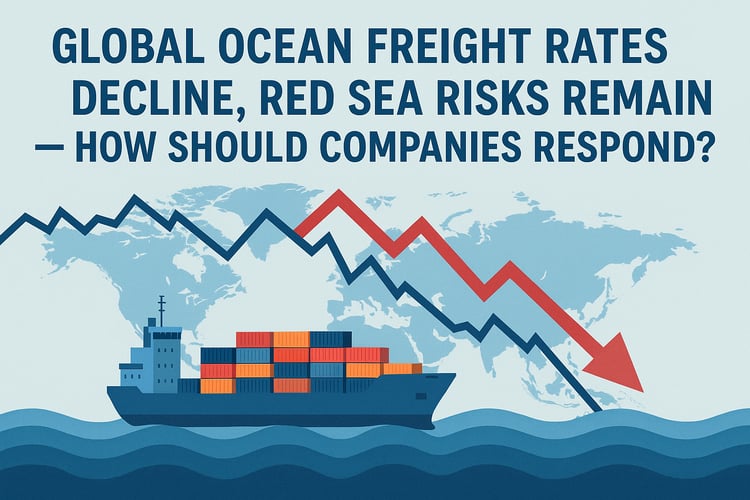Global Ocean Freight Rates Decline, Red Sea Risks Remain — How Should Companies Respond?

Table of Contents
Since the second half of 2024, the global ocean shipping market has shown a pattern of “fluctuation and adjustment.” Under the combined influence of geopolitics, seasonal demand, and capacity deployment, freight rates on different trade lanes have diverged significantly.
For companies expanding overseas, accurately tracking freight rate trends is a key step in controlling costs and optimizing supply chains.
Below are the latest global ocean freight updates and 2025 trend forecasts for reference by exporting companies.
1. Red Sea Diversions Continue to Push Up Asia–Europe Rates, European Port Congestion Worsens
Due to ongoing security risks in the Red Sea region, many global carriers continue to reroute vessels around the Cape of Good Hope in Africa. This diversion strategy, in place since early 2023, shows no sign of easing.
Asia–Northern Europe freight rates have risen significantly: as of early July, rates reached $3,560/FEU, up 50% from late May, though still well below last year’s peak of $8,500/FEU.
European port congestion combined with peak season demand: key hub ports such as Rotterdam and Antwerp have experienced backlogs, further adding upward pressure on rates.
Nevertheless, the delivery of new vessels and overall capacity growth are partially offsetting the upward trend. Carriers have also begun skipping ports and reducing sailings to control costs — a rare practice during peak season.
2. 2025 Outlook: Red Sea Diversions Become the “New Normal,” Capacity Adjustments as the Main Driver
Although disruptions related to the Red Sea are stabilizing, the high costs and long transit times caused by diversions will persist. Unless the situation fully resolves, most carriers will maintain conservative route planning.
Asia–Mediterranean freight rates have fallen: with less impact from the Red Sea and stable capacity, rates on this lane have dropped nearly 20% since mid-June.
Beyond geopolitics, capacity deployment is the core variable: carriers are actively managing route efficiency by cutting services and adjusting port calls.
Forecast: Red Sea diversion strategies will likely continue throughout 2025, with rates heavily dependent on how carriers pace their capacity control.
3. Asia–US Rates Drop as Early Shipping Surge Ends
Ahead of the August 12 US tariff deadline on Chinese goods, many American importers placed orders early and booked space in advance, pushing rates up sharply in mid-June. With the rush now over, demand has dropped significantly.
Asia–US West Coast rates: down from $6,000/FEU at the peak to $2,390/FEU.
Asia–US East Coast rates: down to $4,900/FEU, about 30% lower than the June peak.
With carriers having deployed a large amount of space earlier, the market is now oversupplied. GRI (General Rate Increase) plans have been canceled, and some peak season surcharges have been removed.
Experienced exporters have minimized volatility risks by working with stable freight forwarder networks and booking space in advance. Meanwhile, smaller companies can also manage cross-border logistics more smoothly by leveraging service platforms with overseas warehouses and local operations capabilities.
4. Latest Freight Rate Monitoring

(July 2025 data, source: Freightos Terminal)
Asia–Europe lanes continue to climb due to the Red Sea impact, while US lanes are falling sharply as demand weakens.
5. 2025 Freight Rate Forecast: High Volatility Will Continue, Capacity Control is Key
If the Red Sea situation remains stable, carriers will continue to control rates by skipping ports and reducing sailings.
Supply–demand dynamics will dominate rate movements, with overall trends characterized by high volatility → moderate correction → flexible adjustments.
Currently, many export-oriented companies are considering working with partners that have local warehousing and export agency services, enabling them to consolidate orders and ship in batches to reduce transportation costs and increase flexibility. Abrasivestocks has warehouses in both Germany and Australia, offering convenient options for companies.
6. Recommendations for Exporters
To cope with the current instability in ocean freight prices, companies are advised to:
Compare rates and shipping methods from multiple sources to maximize cost-effectiveness;
Plan shipments in advance to avoid peak seasons and congestion;
Allow budget and lead time buffers to reduce uncertainty risks;
Choose suitable warehousing and customs clearance services to improve end-to-end efficiency;
Maintain real-time communication with freight forwarders to track developments and respond quickly.
For companies with limited cross-border experience, partnering with platforms that know the target country’s market and offer overseas warehousing services can help reduce initial costs and simplify operations.
Conclusion
Although the global shipping market is in a period of adjustment, various structural risks remain unresolved. For Chinese foreign trade enterprises, understanding ocean freight trends and flexibly configuring logistics solutions are key to reducing costs and improving delivery capacity. While rates may still have room to fall, high volatility will be the “new normal” — early planning and dynamic responses are essential.
For more on overseas warehousing services and export logistics arrangements, stay tuned to Abrasivestocks for updates.
Next issue: We will bring you trends and recommendations for the air freight market — stay tuned!



